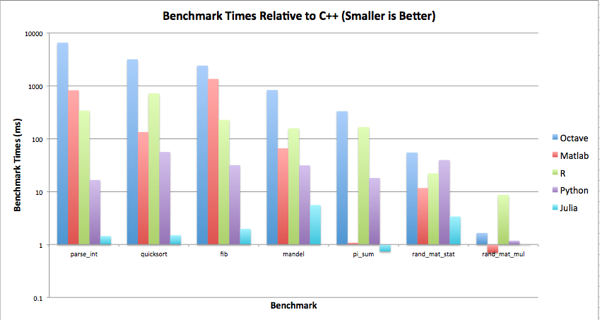
Who is Julia, what is she?
- Started at MIT 2010, mainly seen then as scientific language
- Open-source in 2012 where it's flexibility lead to application in many other fields
- Consists of a Base which is written in Julia
- Base contains all of "numpy", part of "scipy"
- Much of rest is implemented in packages:
- StatsBase
- MultivariateStats
- KernelDensity / KernelEstimator
- Dataframes
- RDatasets
- GLM
- Lora / MCMC
- Clustering
Groups:
JuliaStats, JuliaOpt, JuliaWeb, JuliaQuant, JuliaFinMetriX
JuliaQuant group includes packages such as :
- TimeSeries
- MarketData
- MarketTechnicals
- Quandl
- Ito
- GARCH
Why is Julia special?
- Julia is written in Julia, down to it's cotton socks
- Uses LLVM / JIT compilation
- Homoiconic design: runtime macros
- Code is uncluttered
- Analysts => developers while remaining within Julia
- Written with parallelism in mind
- Spawn tasks, run asynchoronously
- Can connect with modules / libraries in other programming languages

Interoperability with other languages
- C / Fortran : Built-in to BASE with NO overhead
- Java : JavaCall.jl
- C++ : Cpp.jl, Cxx.jl
- R : RIF.jl, RCall.jl
- Python: PyCall.jl, PyPlot.jl, IJulia.jl, PyJulia.jl
- MATLAB: Matlab.jl, MATLABCluster.jl
In [17]:
using PyCall, PyPlot
In [18]:
using PyCall
@pyimport numpy as np
@pyimport numpy.random as nr
S0 = 100.0;
K = 105.0;
T = 1.0;
r = 0.05;
σ = 0.2;
In [19]:
N = 100000;
w = nr.standard_normal(N);
ST = S0*np.exp((r - 0.5*σ*σ)*T + σ*np.sqrt(T)*w);
hT = np.maximum(ST - K, 0);
C0 = np.exp(-r*T) * np.sum(hT)/N;
@printf "Price of %s option is %6.3f\n" "Call" C0
In [20]:
macroexpand(:(@printf "Price of %s option is %6.3f\n" "Call" C0))
Out[20]:
In [21]:
using PyPlot
@pyimport scipy.interpolate as spi
x = linspace(0,10,10);
y = x .* exp(-0.5x) .* sin(x);
f1 = spi.interp1d(x, y);
f2 = spi.interp1d(x, y, kind="cubic");
In [22]:
xx = linspace(0,10,40);
y1 = pycall(f1,PyAny,xx);
y2 = pycall(f2,PyAny,xx);
plot(x,y,"o",xx,y1,"-", xx, y2,"--");
legend(["data", "linear", "cubic"], loc="best");
In []:
In [26]:
using PyPlot
T = 100;
S0 = 100;
dt = 0.01;
v = 0.2;
r = 0.05;
q = 0.0;
x = linspace(1,T);
S = zeros(Float64,T)
S[1] = S0;
iseed = ccall( (:clock, "libc"), Int32, ());
srand(iseed);
dW = randn(T)*sqrt(dt);
[ S[t] = S[t-1] * (1 + (r - q - 0.5*v*v)*dt + v*dW[t] + 0.5*v*v*dW[t]*dW[t]) for t=2:T ]
plot(x,S)
Out[26]:
In [27]:
function asianOpt(N = 10000; S0=100.0, K=100.0)
# European Asian option.
# Euler and Milstein discretization for Black-Scholes.
r = 0.05; # Risk free rate
q = 0.0; # Dividend yield
v = 0.2; # Volatility
tma = 0.25; # Time to maturity
T = 100; # Number of time steps
dt = tma/T; # Time increment
S = zeros(Float64,T);
A = zeros(Float64,N);
for n = 1:N
S[1] = S0
dW = randn(T)*sqrt(dt);
for t = 2:T
z0 = (r - q - 0.5*v*v)*S[t-1]*dt;
z1 = v*S[t-1]*dW[t];
z2 = 0.5*v*v*S[t-1]*dW[t]*dW[t];
S[t] = S[t-1] + z0 + z1 + z2;
end
A[n] = mean(S);
end
# Define the payoff and calculate price
P = zeros(Float64,N);
[ P[n] = max(A[n] - K, 0) for n = 1:N ];
price = exp(-r*tma)*mean(P);
end
Out[27]:
In [28]:
@printf "Option Price: %10.4f\n\n" asianOpt(K = 102.0);
In [29]:
runs = 1000000
tm = @elapsed asianOpt(runs, K=102.0)
@printf "Elapsed time for %d runs is %7.4f sec.\n\n" runs tm

In [31]:
macroexpand(:(@elapsed asianOpt(runs, K=102.0)))
Out[31]:
In []:
macroexpand(:(@printf "Elapsed time for %d simulations is %7.3f sec.\n\n" runs tm ))
In []:

PyJulia adds a Python 'julia' module
Get source from github and use setup.py
Pkg.add("pyjulia")
cd ~/.julia/v0.3/pyjulia
python setup.py install
Speeding up Python execution times
$ python
Python 2.7.9 |Anaconda 2.1.0 (x86_64)
[GCC 4.2.1 (Apple Inc. build 5577)] on darwin
>>> import time as tm
>>> start = tm.time()
>>> asianOpt(1000000,K=102.0)
1.6409
>>> print 'It took', tm.time()-start, 'seconds.'
It took 77.332 seconds.
>>> import julia
>>> jl = julia.Julia()
>>> print jl.bessely0(1.5)
0.3824489237977
>>> import numpy as np
>>> print np.sin(0.5) * jl.bessely0(1.5)
0.1833557812803
>>> jl.require("asian-opt")
>>> jl.asianOpt()
AttributeError: 'Julia' object has no attribute 'asianOpt'
>>> jl.eval("asianOpt(1000000,K=102.0)")
1.6775348594420794
>>> jl.eval("@elapsed asianOpt(1000000,K=102.0)")
3.146388532
In []:
$ more myfinx.py
import datetime
import numpy as np
import matplotlib.colors as colors
import matplotlib.finance as finance
import matplotlib.dates as mdates
import matplotlib.ticker as mticker
import matplotlib.mlab as mlab
import matplotlib.pyplot as plt
import matplotlib.font_manager as font_manager
def moving_average(x, n, type='simple'):
"""
compute an n period moving average.
type is 'simple' | 'exponential'
"""
def relative_strength(prices, n=14):
"""
compute the n period relative strength indicator
http://stockcharts.com/school/doku.php?id=chart_school:glossary_r#relativestrengthindex
http://www.investopedia.com/terms/r/rsi.asp
"""
def moving_average_convergence(x, nslow=26, nfast=12):
"""
compute the MACD (Moving Average Convergence/Divergence) using a fast and slow exponential moving avg'
return value is emaslow, emafast, macd which are len(x) arrays
"""
def run(ticker):
startdate = datetime.date(2000,1,1)
today = enddate = datetime.date.today()
............
............
............
plt.show()
In [32]:
using PyCall
@pyimport myfinx as fx
fx.run("MSFT")

- Julia Main Page : http://www.julialang.org
- Julia Wiki Book : https://en.wikibooks.org/wiki/Introducing_Julia
- London Julia UG : http://londonjulia.org
- JuliaStats Group : http://JuliaStats.org
- JuliaOpt Group : http://JuliaOpt.org
- JuliaQuant Group : https://github.com/JuliaQuant
- JuliaFinMetriX : https://github.com/JuliaFinMetriX
- JuliaEconomics : http://juliaeconomics.com/tutorials
- Quant-Econ.net : http://quant-econ.net
- Steven Johnson EuroSciPy 2014 Keynote Speech : https://www.youtube.com/watch?v=jhlVHoeB05A
- Contact ME : malcolm@amisllp.com
In []: